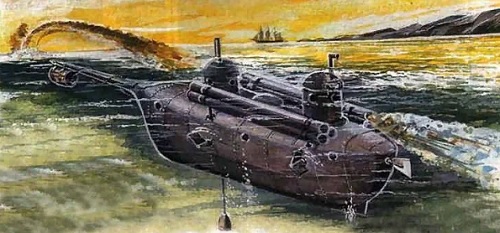It looks like you're using an Ad Blocker.
Please white-list or disable AboveTopSecret.com in your ad-blocking tool.
Thank you.
Some features of ATS will be disabled while you continue to use an ad-blocker.
13
share:

At the beginning of the 19th century, the Russian military engineer Karl Schilder proposed to the Maritime Department a project of a submarine capable of striking missiles from under water. The very idea of submarines at that time was not new. For example, the Fulton submarine was known. But missile armament on submarines ... The naval officials found this idea so innovative that they approved the project, but the inventor himself was responsible for the costs of building the "hidden ship". Expenses amounted to 13,448 rubles. True, the government subsequently reimbursed Schilder for these expenses.
The Schilder submarine had an all-metal structure, length - 6 m, width - 1.5 m and height - 1.8 m.Its displacement was 16.4 tons, and the crew was 10 people, recruited from the Life Guards of the Sapper Battalion and the Marine Guards crew. The boat could dive to a depth of 12 meters and remain submerged for up to half an hour. She even had a periscope - primitive by modern standards, but which was the pinnacle of technical thought for that time, an air intake and a piston pump designed by Major General Sablukov, for pumping air in a submerged position, without surfacing.
The armament of the submarine consisted of one pole mine on a bowsprit extended far forward, with an electric fuse, and 6 four-inch (102 mm) Kongreve powder rockets in horizontal rails, the elevation angle of which was 12 degrees. The design of the guides was developed by Second Lieutenant Pyotr Kovalevsky, who also commanded the training salvo.
After installing the missiles in the guides (sealed pipes), they were tightly closed with rubber plugs, and the boat became capable of diving. Guidance was carried out by the entire hull of the boat, adjusted using a periscope, and the salvo was carried out using an electric launch system, from a galvanic battery. By the way, this system also became the world's first electric missile launch system.

Schilder's boat, in fact, did not have an engine. Then the first steam installations already existed, but they were so cumbersome that there was no need to think about installing them in such a tiny boat. Therefore, the propellers were rowing blades located on the sides, which were rotated by living people - the lower ranks of the Guards Navy crew. The speed in the submerged position was scanty - only 670 m / h. On the other hand, a compact mast with a sail, which was easily retracted inside when an underwater attack was necessary, served for the course in the surface position.
An additional weapon was a pole mine on an easily removable clutch, also with an electric detonation system. Such systems were then implemented in surface combat boats. According to Schilder's plan, the boat was supposed to get under the water under the bottom of the enemy ship, drive a sharp tip into it, under which a mine was attached, and quietly move back - at a distance of the length of the electric wire. After that, the contacts of the galvanic battery were closed on the boat - and bang! ..
On September 10, 1834, on the Neva, near St. Petersburg, but in a sparsely populated place, in the presence of Emperor Nicholas the First, Schilder's submarine launched the world's first missile salvo from under the water - for training purposes, which served as anchored wooden scows. The targets were hit by the first launch.
Then the pole mine was successfully tested.
The British ambassador, who was deliberately aware of the results of the experiment, is said to have fallen into prostration for a while. The power of Britain then was based on the power of the "Grand Fleet", which would have absolutely nothing to oppose to the "wunderwaffe" of these crazy Russians)))
On July 6, 1838, a second underwater salvo was fired at Kronstadt.
Unfortunately, Schilder's boat did not go into mass production. For its time, it was extremely difficult to manufacture, expensive, and most importantly - almost unable to move under water on its own. The "muscle" mover was not suitable for this at all, and there were no other suitable ones at that time. By order of the emperor, the project was classified, and the classification was removed only after 40 years. But, perhaps, it still played an important role in the country's defense capability. There is a version that during the Crimean War the British fleet did not approach Kronstadt, including for the reason that the British were completely unaware of how many "hidden ships" there were then in the Russian fleet, but were sufficiently aware of the firepower of even one such ship.
Thank!
Thank you for the thread.
That was a great read. I love naval history!
Has Russia ever had a great ship, such as the US had The Enterprise?
Not something like The Hood though. Got blown away in its first serious fight!
P
That was a great read. I love naval history!
Has Russia ever had a great ship, such as the US had The Enterprise?
Not something like The Hood though. Got blown away in its first serious fight!
P
Terrific story!
I'm a little confused about the missile/tube launchers. It sounded like they needed rubber plugs to cap the tube ends whilst diving, obviously to keep the contents dry. From the picture you included, it seems to portray the submersible launching munitions from the tube //above the water//.
So was the submersible actually capable of using the launch tubes underwater? From the description of the rubber caps, and the illustration you provide, it almost seems like it'd need to surface first before using them.
Either way, thanks for posting
I'm a little confused about the missile/tube launchers. It sounded like they needed rubber plugs to cap the tube ends whilst diving, obviously to keep the contents dry. From the picture you included, it seems to portray the submersible launching munitions from the tube //above the water//.
So was the submersible actually capable of using the launch tubes underwater? From the description of the rubber caps, and the illustration you provide, it almost seems like it'd need to surface first before using them.
Either way, thanks for posting
originally posted by: pheonix358
Thank you for the thread.
That was a great read. I love naval history!
Has Russia ever had a great ship, such as the US had The Enterprise?
Not something like The Hood though. Got blown away in its first serious fight!
P
Russia did not pursue a colonial policy. Therefore, Russia did not need such large ships and aircraft carriers. The Russians have a completely different naval concept.
originally posted by: SleeperHasAwakened
Terrific story!
I'm a little confused about the missile/tube launchers. It sounded like they needed rubber plugs to cap the tube ends whilst diving, obviously to keep the contents dry. From the picture you included, it seems to portray the submersible launching munitions from the tube //above the water//.
So was the submersible actually capable of using the launch tubes underwater? From the description of the rubber caps, and the illustration you provide, it almost seems like it'd need to surface first before using them.
Either way, thanks for posting
Indeed, the rockets were launched from an underwater state. In the surface state, the missiles would fly strictly horizontally. The boat was positioned under water for a salvo using a periscope. Of course, the depth was minimal, but it was)))
Technical note regarding the English language.
It would be more accurate to refer to the weapons as 'rockets' vice 'missiles'.
It is true that 'missile' can be used for practically any projectile, but in the sense of weapons of a submarine, 'missile' is not accurate because these rockets did not have true guidance systems.
That said, it is interesting how old some of these concepts are. Nothing new under the sun it seems.
Cheers to you, RT
It would be more accurate to refer to the weapons as 'rockets' vice 'missiles'.
It is true that 'missile' can be used for practically any projectile, but in the sense of weapons of a submarine, 'missile' is not accurate because these rockets did not have true guidance systems.
That said, it is interesting how old some of these concepts are. Nothing new under the sun it seems.
Cheers to you, RT
originally posted by: F2d5thCavv2
Technical note regarding the English language.
It would be more accurate to refer to the weapons as 'rockets' vice 'missiles'.
It is true that 'missile' can be used for practically any projectile, but in the sense of weapons of a submarine, 'missile' is not accurate because these rockets did not have true guidance systems.
That said, it is interesting how old some of these concepts are. Nothing new under the sun it seems.
Cheers to you, RT
Let's drink together, my friend)))

a reply to: RussianTroll
Looks great, RT, especially that bacon!
Love the pickels, true Slavic fare
Cheers
Looks great, RT, especially that bacon!
Love the pickels, true Slavic fare
Cheers
originally posted by: F2d5thCavv2
a reply to: RussianTroll
Looks great, RT, especially that bacon!
Love the pickels, true Slavic fare
Cheers
You forgot the black rye bread. This is a necessary ingredient))))
new topics
-
Cutting Boards
Food and Cooking: 9 minutes ago -
Mexico Plans Alert App For Migrants Facing Arrest In US
Mainstream News: 1 hours ago -
Why Such An Uproar Over Non-US Citizens With H1-B Work Visas.
Social Issues and Civil Unrest: 6 hours ago -
Christmas Car Near Detroit…
Automotive Discussion: 8 hours ago -
Assetto Corsa EVO - a New Chapter in Simracing starts January 16th
Video Games: 10 hours ago
top topics
-
Why Such An Uproar Over Non-US Citizens With H1-B Work Visas.
Social Issues and Civil Unrest: 6 hours ago, 8 flags -
The Phenomenon documentary by James Fox
Aliens and UFOs: 14 hours ago, 7 flags -
Christmas Car Near Detroit…
Automotive Discussion: 8 hours ago, 5 flags -
The Looking Glass - Episode 3: The Path of Least Resistance
Short Stories: 17 hours ago, 3 flags -
Mexico Plans Alert App For Migrants Facing Arrest In US
Mainstream News: 1 hours ago, 3 flags -
New UK Petition - Close the borders! Suspend ALL immigration for 5 years!
Regional Politics: 15 hours ago, 2 flags -
Assetto Corsa EVO - a New Chapter in Simracing starts January 16th
Video Games: 10 hours ago, 2 flags -
Cutting Boards
Food and Cooking: 9 minutes ago, 0 flags
active topics
-
Mexico Plans Alert App For Migrants Facing Arrest In US
Mainstream News • 4 • : TzarChasm -
Cutting Boards
Food and Cooking • 0 • : Flyingclaydisk -
New York Governor signs Climate Law that Fines Fossil Fuel Companies
US Political Madness • 32 • : confuzedcitizen -
Why Such An Uproar Over Non-US Citizens With H1-B Work Visas.
Social Issues and Civil Unrest • 29 • : StoutBroux -
Waterloo in 20mm world's largest diorama (on view at NAM Chelsea Oct 20 & 21) new pics added 10 -16
Member Art • 52 • : Asktheanimals -
The Phenomenon documentary by James Fox
Aliens and UFOs • 4 • : bscotti -
Christmas Car Near Detroit…
Automotive Discussion • 6 • : JJproductions -
Plane Crash Today --Azerbaijanian E190 passenger jet
Mainstream News • 67 • : andy06shake -
Credit card debt
Relationships • 6 • : confuzedcitizen -
Spiritual Solstice
Short Stories • 18 • : argentus
13
